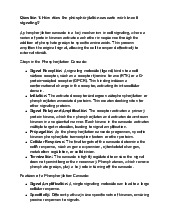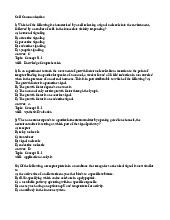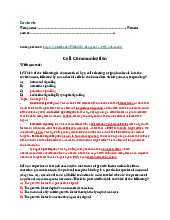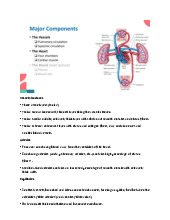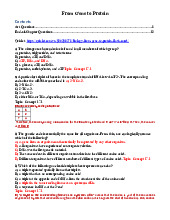












Preview text:
lOMoAR cPSD| 59085392 Contents
Multiple-Choice Questions ....................................................................................................................... 1
Art Questions ............................................................................................................................................ 7
End-of-Chapter Questions ..................................................................................................................... 12
Link quizlet: https://quizlet.com/vn/926447011/biology-the-cell-cycle-flash-cards/ The Cell Cycle
Multiple-Choice Questions
1) The centromere (tâm động) is a region in which
A) chromatids remain attached to one another until anaphase.
B) metaphase chromosomes become aligned at the metaphase plate.
C) chromosomes are grouped during telophase.
D) the nucleus is located prior to mitosis.
E) new spindle microtubules form at either end.Topic: Concept 12.1
2) Starting with a fertilized egg (zygote), a series of five cell divisions would produce an early
embryo with how many cells? A) 4 B) 8 C) 16 D) 32 E) 64 Topic: Concept 12.1
3) If there are 20 chromatids in a cell, how many centromeres are there? A) 10 B) 20 C) 30 D) 40 E) 80 Topic: Concept 12.1
5) Suppose a biologist can separate one of a dozen pieces of chromatin from a eukaryotic (animal)
nucleus. It might consist of which of the following?
A) one-twelfth of the genes of the organism
B) two chromosomes, each with six chromatids
C) a single circular piece of DNA
D) two long strands of DNA plus proteins
E) two chromatids attached together at a centromereTopic: Concept 12.1
6) At which phase are centrioles beginning to move apart in animal cells? A) telophase lOMoAR cPSD| 59085392 B) anaphase C) prometaphase D) metaphase E) prophase Topic: Concept 12.2
8) If there are 20 centromeres in a cell at anaphase, how many chromosomes are there in each
daughter cell following cytokinesis? A) 10 B) 20 C) 30 D) 40 E) 80 Topic: Concept 12.2
10) Taxol is an anticancer drug extracted from the Pacific yew tree. In animal cells, Taxol disrupts
microtubule formation by binding to microtubules and accelerating their assembly from the
protein precursor, tubulin. Surprisingly, this stops mitosis. Specifically, Taxol must affect A) the
formation of the mitotic spindle. B) anaphase.
C) formation of the centrioles. D) chromatid assembly.
E) the S phase of the cell cycle.Topic: Concept 12.2
13) Movement of the chromosomes during anaphase would be most affected by a drug that
A) reduces cyclin concentrations.
B) increases cyclin concentrations.
C) prevents elongation of microtubules.
D) prevents shortening of microtubules.
E) prevents attachment of the microtubules to the kinetochore.Topic: Concept 12.2
14) Measurements of the amount of DNA per nucleus were taken on a large number of cells from a
growing fungus. The measured DNA levels ranged from 3 to 6 picograms per nucleus. In which
stage of the cell cycle did the nucleus contain 6 picograms of DNA? A) G0 B) G1 C) S D) G2 E) M Topic: Concept 12.2
15) A group of cells is assayed for DNA content immediately following mitosis and is found to have
an average of 8 picograms of DNA per nucleus. How many picograms would be found at the end of S and the end of G2? A) 8; 8 B) 8; 16 C) 16; 8 lOMoAR cPSD| 59085392 D) 16; 16 E) 12; 16 Topic: Concept 12.2
Cells have an average of 8 picograms of DNA per nucleus. - End of S
phase: During S phase, DNA replication occurs.
- End of G2 phase: There is no further DNA replication during G2 phase; thus, the DNA content remains the same as at the end of S phase.
16) For anaphase to begin, which of the following must occur?
A) Chromatids must lose their kinetochores.
B) Cohesin must attach the sister chromatids to each other.
C) Cohesin must be cleaved enzymatically.
D) Kinetochores must attach to the metaphase plate.
E) Spindle microtubules must begin to depolymerize.Topic: Concept 12.2
17) Why do chromosomes coil during mitosis?
A) to increase their potential energy
B) to allow the chromosomes to move without becoming entangled (bị vướng víu) and breaking
C) to allow the chromosomes to fit within the nuclear envelope
D) to allow the sister chromatids to remain attached
E) to provide for the structure of the centromereTopic: Concept 12.2
22) Which of the following is (are) required for motor proteins to function in the movement of
chromosomes toward the poles of the mitotic spindle? A) intact centromeres
B) an MTOC (microtubule organizing center)
C) a kinetochore attached to the metaphase plate
D) ATP as an energy source
E) synthesis of cohesinTopic: Concept 12.2
23) What is a cleavage furrow?
A) a ring of vesicles forming a cell plate
B) the separation of divided prokaryotes
C) a groove in the plasma membrane between daughter nuclei
D) the metaphase plate where chromosomes attach to the spindle
E) the space that is created between two chromatids during anaphaseTopic: Concept 12.2
27) A plant-derived protein known as colchicine can be used to poison cells by blocking the
formation of the spindle. Which of the following would result if colchicine is added to a sample of cells in G2?
A) The cells would immediately die.
B) The cells would be unable to begin M and stay in G2.
C) The chromosomes would coil and shorten but have no spindle to which to attach.
D) The chromosomes would segregate but in a disorderly pattern.
E) Each resultant daughter cell would also be unable to form a spindle. Topic: Concept 12.2
29) Which of the following is released by platelets in the vicinity of an injury? lOMoAR cPSD| 59085392 A) PDGF B) MPF C) protein kinase D) cyclin E) Cdk Topic: Concept 12.3
30) Which of the following is a protein synthesized at specific times during the cell cycle that
associates with a kinase to form a catalytically active complex? A) PDGF B) MPF C) protein kinase D) cyclin E) Cdk Topic: Concept 12.3
31) Which of the following is a protein maintained at constant levels throughout the cell cycle that
requires cyclin to become catalytically active? A) PDGF B) MPF C) protein kinase D) cyclin E) Cdk Topic: Concept 12.3
32) Which of the following triggers the cell's passage past the G2 checkpoint into mitosis? A) PDGF B) MPF C) protein kinase D) cyclin E) Cdk Topic: Concept 12.3
33) The cyclin component of MPF is destroyed toward the end of which phase? A) G0 B) G1 C) S D) G2 E) M Topic: Concept 12.3
34) Proteins that are involved in the regulation of the cell cycle, and that show fluctuations in
concentration during the cell cycle, are called A) ATPases. B) kinetochores. C) Kinases. D) proton pumps. E) cyclins. lOMoAR cPSD| 59085392 Topic: Concept 12.3
Cyclins are proteins that regulate the cell cycle by binding to and activating cyclindependent kinases (CDKs).
Their concentrations fluctuate throughout the cell cycle.
35) The MPF protein complex turns itself off by A)
activating a process that destroys cyclin components.
B) activating an enzyme that stimulates cyclin. C) binding to chromatin. D) exiting the cell.
E) activating the anaphase-promoting complex.Topic: Concept 12.3
37) Density-dependent inhibition is explained by which of the following? A)
As cells become more numerous, they begin to squeeze against each other, restricting their size
and ability to produce control factors. B)
As cells become more numerous, the cell surface proteins of one cell contact the adjoining
cells and they stop dividing. C)
As cells become more numerous, the protein kinases they produce begin to compete with each
other, such that the proteins produced by one cell essentially cancel those produced by its neighbor. D)
As cells become more numerous, more and more of them enter the S phase of the cell cycle.
E) As cells become more numerous, the level of waste products increases, eventually slowing down metabolism. Topic: Concept 12.3
39) Which of the following describe(s) cyclin-dependent kinase (Cdk)?
A) Cdk is inactive, or "turned off," in the presence of cyclin.
B) Cdk is present throughout the cell cycle.
C) Cdk is an enzyme that attaches phosphate groups to other proteins.
D) Cdk is inactive, or "turned off," in the presence of cyclin and it is present throughout the cell cycle.
E) Cdk is present throughout the cell cycle and is an enzyme that attaches phosphate groups to other proteins. Topic: Concept 12.3
40) A particular cyclin called cyclin E forms a complex with Cdk 2 (cyclin-dependent kinase 2).
This complex is important for the progression of the cell from G1 into the S phase of the cell cycle.
Which of the following statements is correct?
A) The amount of free cyclin E is greatest during the S phase.
B) The amount of free Cdk 2 is greater during G1 compared to the S phase.
C) The amount of free cyclin E is highest during G1.
D) The amount of free Cdk 2 is greatest during G1.
E) The activity of the cyclin E/Cdk 2 complex is highest during G2. Topic: Concept 12.3
During G1, particularly late G1, the synthesis of cyclin E is ramping up in preparation for the S phase, leading
to the highest levels of free cyclin E in the cell. A) The amount of free cyclin E is greatest during the S G1 phase.
B) The amount of free Cdk 2 is greater during G1 compared to the S phase generally remain constant.
D) The amount of free Cdk 2 is greatest during G1 generally remain constant. lOMoAR cPSD| 59085392
E) The activity of the cyclin E/Cdk 2 complex is highest is degraded during G2.
42) Besides the ability of some cancer cells to overproliferate (tăng sinh quá mức), what else could
logically result in a tumor? A) metastasis
B) changes in the order of cell cycle stages
C) lack of appropriate cell death D) inability to form spindles
E) inability of chromosomes to meet at the metaphase plateTopic: Concept 12.3
43) After which checkpoint is the cell first committed to continue the cell cycle through M? A) G0 B) G1 C) G2 D) S E) previous M Topic: Concept 12.3
Once a cell passes the G1 checkpoint, it is committed to continuing through the rest of the cell cycle, including
the synthesis (S), G2, and mitosis (M) phases.
44) Why do neurons and some other specialized cells divide infrequently?
A) They no longer have active nuclei.
B) They no longer carry receptors for signal molecules.
C) They have been shunted into G0.
D) They can no longer bind Cdk to cyclin.
E) They show a drop in MPF concentration. Answer: C Topic: Concept 12.3
Neurons and some other specialized cells divide infrequently because they have exited the active cell cycle
and entered the G0 phase. In this phase, they perform their specialized functions without preparing for or undergoing cell division.
45) Which of the following most accurately describes a cyclin?
A) It is present in similar concentrations throughout the cell cycle.
B) It is activated to phosphorylate by complexing with a Cdk.
C) It decreases in concentration when MPF activity increases.
D) It activates a Cdk molecule when it is in sufficient concentration.
E) It activates a Cdk when its concentration is decreased.Topic: Concept 12.3
46) All cell cycle checkpoints are similar in which way?
A) They respond to the same cyclins.
B) They utilize the same Cdks.
C) They give the go-ahead signal to progress to the next checkpoint.
D) They each have only one cyclin/Cdk complex.
E) They activate or inactivate other proteins. Topic: Concept 12.3 lOMoAR cPSD| 59085392
49) A research team began a study of a cultured cell line. Their preliminary observations showed
them that the cell line did not exhibit either density-dependent inhibition or anchorage
dependence. What could they conclude right away? A) The cells originated in the nervous system.
B) The cells are unable to form spindle microtubules.
C) They have altered series of cell cycle phases.
D) The cells show characteristics of tumors.
E) They were originally derived from an elderly organism. Topic: Concept 12.3
Tumor cells commonly lose these regulatory mechanisms: density-dependent inhibition or anchorage
dependence, allowing them to proliferate uncontrollably, which is a hallmark of cancer.
50) For a chemotherapeutic (hóa trị) drug to be useful for treating cancer cells, which of the
following is most desirable (mong muốn)? A) It is safe enough to limit all apoptosis.
B) It does not alter metabolically active cells.
C) It only attacks cells that are density dependent.
D) It interferes with cells entering G0.
E) It interferes with rapidly dividing cells.Topic: Concept 12.3
51) You have a series of cells, all of which were derived from tumors, and you first need to find out
which ones are malignant (ác tính). What could you do? A) See which ones are not overproliferating.
B) Find out which ones have a higher rate of apoptosis.
C) Karyotype samples to look for unusual size and number of chromosomes. D) Measure metastasis. E) Time their cell cycles. Topic: Concept 12.3
Karyotyping is a powerful technique for detecting chromosomal abnormalities associated with malignancy. By
analyzing the karyotypes of the tumor-derived cells, researchers can identify unusual sizes and numbers of
chromosomes, which are indicative of malignant transformation. Art Questions
Use the following information to answer the questions below.
The lettered circle in Figure 12.1 shows a diploid nucleus with four chromosomes. There are two
pairs of homologous chromosomes, one long and the other short. One haploid set is symbolized as
black and the other haploid set is gray. The chromosomes in the unlettered circle have not yet
replicated. Choose the correct chromosomal conditions for the following stages. ***Figure 12.1 lOMoAR cPSD| 59085392
52) What is the correct chromosomal condition at the prometaphase of mitosis? A) A B) B C) C D) D E) E Topic: Concept 12.2
53) What is the correct chromosomal condition for one daughter nucleus at telophase of mitosis? A) A B) B C) C D) D E) E Topic: Concept 12.2 ***Figure 12.2
54) If the cell whose nuclear material is shown in Figure 12.2 continues toward completion of
mitosis, which of the following events would occur next? lOMoAR cPSD| 59085392 A) cell membrane synthesis B) spindle fiber formation C) nuclear envelope breakdown
D) formation of telophase nuclei
E) synthesis of chromatidsTopic: Concept 12.2
***The following questions are based on Figure 12.3. Figure 12.3
55) In the figure above, mitosis is represented by which numbered part(s) of the cycle? A) I B) II C) III D) IV E) V Topic: Concept 12.2
I: This part represents G1 phase where the cell has a normal diploid amount of DNA. II: This is the S phase
where DNA is being replicated, so the amount of DNA is increasing.
III: This is the G2 phase where the cell has completed DNA replication and now has double the normal amount of DNA.
IV: This represents the M phase (mitosis) where the cell divides, resulting in two daughter cells, each
with the normal diploid amount of DNA. V: This part represents the G1 phase of the second cycle.
56) G1 is represented by which numbered part(s) of the cycle? A) I or V B) II or IV C) III only D) IV only E) V only Topic: Concept 12.2
57) Which number represents DNA synthesis? A) I B) II C) III D) IV E) V lOMoAR cPSD| 59085392 Topic: Concept 12.2
58) Which number represents the point in the cell cycle during which the chromosomes are replicated? A) I B) II C) III D) IV E) V Topic: Concept 12.2
59) At which of the numbered regions would you expect to find cells at metaphase? A) I and IV B) II only C) III only D) IV only E) V only Topic: Concept 12.2
Region III (G2 phase) represents the cells just before entering mitosis, making them ready to enter metaphase soon.
60) MPF reaches its threshold concentration at the end of this stage. A) I B) II C) III D) IV E) V Topic: Concept 12.3
MPF reaches its threshold concentration at the end of the G2 phase to trigger the onset of mitosis.
Use the data in Table 12.1 to answer the following questions.
The data were obtained from a study of the length of time spent in each phase of the cell cycle by
cells of three eukaryotic organisms designated beta, delta, and gamma.
Table 12.1: Minutes Spent in Cell Cycle Phases
61) Of the following, the best conclusion concerning the difference between the S phases for beta and gamma is that
A) gamma contains more DNA than beta.
B) beta and gamma contain the same amount of DNA.
C) beta cells reproduce asexually.
D) gamma contains 48 times more DNA and RNA than beta. lOMoAR cPSD| 59085392
E) beta is a plant cell and gamma is an animal cell.Topic: Concept 12.2
62) The best conclusion concerning delta is that the cells A) contain no DNA. B) contain no RNA.
C) contain only one chromosome that is very short.
D) are actually in the G0 phase.
E) divide in the G1 phase. Topic: Concept 12.2 Scenario Questions
Use the following information to answer the questions below.
Nucleotides can be radiolabeled before they are incorporated into newly forming DNA and can
therefore be assayed to track their incorporation. In a set of experiments, a student—faculty
research team used labeled T nucleotides and introduced these into the culture of dividing human cells at specific times.
65) Which of the following questions might be answered by such a method?
A) How many cells are produced by the culture per hour?
B) What is the length of the S phase of the cell cycle?
C) When is the S chromosome synthesized?
D) How many picograms of DNA are made per cell cycle?
E) When do spindle fibers attach to chromosomes? Topic: Concept 12.2
This method is particularly useful for studying the S phase of the cell cycle, during which DNA replication occurs.
This allows them to determine the duration of the S phase by observing the period during which the labeled
thymidine is incorporated into the DNA.
66) The research team used the setup to study the incorporation of labeled nucleotides into a
culture of lymphocytes and found that the lymphocytes incorporated the labeled nucleotide at a
significantly higher level after a pathogen was introduced into the culture. They concluded that
A) the presence of the pathogen made the experiment too contaminated to trust the results.
B) their tissue culture methods needed to be relearned.
C) infection causes lymphocytes to divide more rapidly.
D) infection causes cell cultures in general to reproduce more rapidly.
E) infection causes lymphocyte cultures to skip some parts of the cell cycle.Topic: Concept 12.2
Use the following information to answer the questions below.
The research team established similar lymphocyte cultures from a number of human donors,
including healthy teenagers of both genders, patients already suffering from long-term bacterial
infections, and elderly volunteers. They found that the increase in lymphocyte incorporation after
pathogen introduction was slightly lower in some of the female teenagers and significantly lower
in each of the elderly persons. They repeated the study with a larger number of samples but got the same results.
68) What might be among the research team's conclusions?
A) The young women showed these results because they have poorer nutrition. lOMoAR cPSD| 59085392
B) The elderly persons' samples demonstrated their lowered immune responses.
C) The young men had higher responses because they are generally healthier.
D) The patient samples should have had the lowest response but did not, so the experiment is invalid.
E) The elderly donor samples represent cells no longer capable of any cell division.Topic: Concept 12.3
69) Which of the following investigations might be most productive to show what the data on the
teenagers might indicate? A) test male teenagers
B) test teenagers who say they are not sexually active
C) test female teens at different times in their menstrual cycles
D) test relatives of the teens previously tested
E) test teenagers from different school systems Topic: Concept 12.3
Hormonal changes during menstruation might affect immune cell activation and proliferation.
Use the following information to answer the questions below.
A student is looking through his light microscope (~450 X) at a squashed and stained onion root
tip. Some, but not all, of the cells have clearly visible chromosome strands.
70) When a cell is in anaphase of mitosis, which of the following will he see?
A) a clear area in the center of the cell
B) chromosomes clustered at the poles
C) individual chromatids separating
D) chromosomes clustered tightly at the center
E) formation of vesicles at the midlineTopic: Concept 12.2
71) When the cell has just completed telophase, which of the following does he see?
A) a clear area in the center of the cell
B) chromosomes clustered at the polesC) individual chromatids separating
D) formation of vesicles at the midline
E) two small cells with chromatinTopic: Concept 12.2
End-of-Chapter Questions
The following questions are from the end-of-chapter “Test Your Understanding” section in
Chapter 12 of the textbook.
73) Vinblastine is a standard chemotherapeutic (hóa trị liệu) drug used to treat cancer. Because it
interferes with the assembly of microtubules, its effectiveness must be related to A) disruption
of mitotic spindle formation.
B) inhibition of regulatory protein phosphorylation.
C) suppression of cyclin production.
D) myosin denaturation and inhibition of cleavage furrow formation.
E) inhibition of DNA synthesis.
Topic: End-of-Chapter Questions lOMoAR cPSD| 59085392
74) One difference between cancer cells and normal cells is that cancer cells
A) are unable to synthesize DNA.
B) are arrested at the S phase of the cell cycle.
C) continue to divide even when they are tightly packed together.
D) cannot function properly because they are affected by density-dependent inhibition.
E) are always in the M phase of the cell cycle.
75) The decline of MPF activity at the end of mitosis is due to
A) the destruction of the protein kinase Cdk.
B) decreased synthesis of Cdk. C) the degradation of cyclin.
D) the accumulation of cyclin. E) synthesis of DNA.
76) In the cells of some organisms, mitosis occurs without cytokinesis (quá trình phân chia tế bào). This will result in
A) cells with more than one nucleus.
B) cells that are unusually small. C) cells lacking nuclei.
D) destruction of chromosomes.
E) cell cycles lacking an S phase.
77) Which of the following does not occur during mitosis?
A) condensation of the chromosomes B) replication of the DNA
C) separation of sister chromatids D) spindle formation
E) separation of the spindle poles
78) A particular cell has half as much DNA as some other cells in a mitotically active tissue. The
cell in question is most likely in A) G1. B) G2. C) prophase. D) metaphase. E) anaphase.
